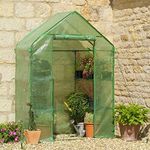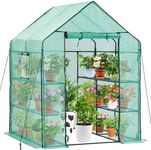Buying Guide for the Best Cold Frames
Cold frames are essential tools for gardeners who want to extend their growing season, protect young plants, and start seedlings earlier in the year. They act as mini-greenhouses, providing a controlled environment that shields plants from harsh weather conditions. When choosing a cold frame, it's important to consider several key specifications to ensure it meets your gardening needs and climate conditions. Here are the key specs to look out for and how to choose the best fit for you.MaterialThe material of a cold frame is crucial as it affects durability, insulation, and light transmission. Common materials include wood, aluminum, and plastic for the frame, and glass, polycarbonate, or plastic for the cover. Wood is aesthetically pleasing and provides good insulation but may require more maintenance. Aluminum is lightweight, durable, and low-maintenance but may not insulate as well. Plastic frames are affordable and lightweight but less durable. For the cover, glass offers excellent light transmission and durability but is heavy and can break easily. Polycarbonate is lightweight, durable, and provides good insulation but may yellow over time. Plastic covers are affordable and lightweight but less durable and may not provide as much insulation. Choose a material based on your priorities for durability, maintenance, and insulation.
SizeThe size of the cold frame determines how many plants you can grow and how much space it will occupy in your garden. Small cold frames are suitable for limited spaces and a few plants, making them ideal for beginners or those with small gardens. Medium-sized cold frames offer a balance between space and capacity, suitable for most home gardeners. Large cold frames provide ample space for a variety of plants and are ideal for serious gardeners with larger gardens. Consider the number of plants you want to grow and the available space in your garden when choosing the size.
VentilationVentilation is important to regulate temperature and humidity inside the cold frame, preventing overheating and promoting healthy plant growth. Cold frames can have manual or automatic ventilation systems. Manual systems require you to open and close vents or lids, giving you control but requiring regular attention. Automatic systems use temperature-sensitive mechanisms to open and close vents, providing convenience and consistent regulation. Choose a ventilation system based on your availability to monitor the cold frame and your preference for manual control or automation.
InsulationInsulation helps maintain a stable temperature inside the cold frame, protecting plants from extreme cold and temperature fluctuations. Better insulation allows for a longer growing season and better plant protection. Cold frames with double-walled covers or insulated panels provide superior insulation compared to single-walled or non-insulated options. Consider the climate in your area and the level of protection your plants need when evaluating insulation.
Ease of AssemblyEase of assembly is important, especially if you are not particularly handy or have limited time. Some cold frames come pre-assembled or with easy-to-follow instructions and minimal parts, making them quick and simple to set up. Others may require more time and effort to assemble, with more complex instructions and numerous parts. Consider your comfort level with assembly and the time you have available when choosing a cold frame.
PortabilityPortability refers to how easily you can move the cold frame around your garden. Lightweight and compact cold frames are easier to move, allowing you to reposition them as needed to optimize sunlight exposure or protect different plants. Heavier and larger cold frames may be more challenging to move but can provide more stability and protection. Consider how often you may need to move the cold frame and your ability to do so when evaluating portability.













